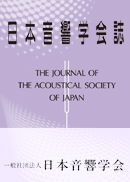All issues

Volume 12 (1956)
- Issue 4 Pages 189-
- Issue 3 Pages 137-
- Issue 2 Pages 55-
- Issue 1 Pages 1-
Volume 12, Issue 2
Displaying 1-12 of 12 articles from this issue
- |<
- <
- 1
- >
- >|
-
Juichi IgarashiArticle type: Article
1956Volume 12Issue 2 Pages 55-62
Published: 1956
Released on J-STAGE: June 02, 2017
JOURNAL FREE ACCESSExplosive pulse waves produced by a pistol shot were photographed by the Schlieren method. They consist of 3 or 4 wave surfaces and the duration of one wave is about 10 micro-seconds. Theinterval of each wave front is about 100 or 200 micro-seconds. Their propagation velocity seems to become normal at one milli-seconds after explosion. But the waveform of the pulse is different when we observe it through the electro-acoustical instruments such as a microphone, an amplifier and a cathode-ray oscillograph because it is dependent on the frequency characteristics of the measuring system. The photographs obtained in this case showed that only one wave was predominant and the duration of this pulse was about a few hundred micro-seconds. Flutter echo in a straight tube generated by a recorded pistol shot was observed. The frequency components of a series of pulse waves of equal were obtained experimentally and theoretically. When the pulse duration time τ is adequately smaller than the time interval between reflected pulses T, following result is obtained by Fourier's integral. a(ν)=(P0/π)[sin( πντ)/πν][1/2+cos2πνT+cos2(2πνT)+..+cos n(2πνT)] (2n+1) is the number of pulses under consideration. If the observation is made by the instrument whose frequency response is R(ν), then the frequency component will be a(ν) R(ν), and the wave from is expressed as P(t)=∫^∞ -∞ a(ν) R(ν) exp(-2πiνt)dt The relation between the peak level of the pistol shot observed in the reverberation measurement and the writing speed of the recorder was measured by means of a high speed level recorder. The experiments on 20 shots showed that the deviation of peak level was about 2 db and was independent of the writing speed.View full abstractDownload PDF (1187K) -
Isao Yokoyama, Kiyoshi AwayaArticle type: Article
1956Volume 12Issue 2 Pages 63-75
Published: 1956
Released on J-STAGE: June 02, 2017
JOURNAL FREE ACCESSSince the absorption coefficient of sound absorbing materials are considerably dependent upon the condition of the space behind the materials, it become necessary to regard the absorbing material as an acoustical four-terminal network and obtain the four-terminal coefficients for its study. Two methods of obtaining the acoustical four-terminal coefficients are shown in this paper. In one method the elements of the S-matrix are obtained graphically from the values of the reflection coefficient under different lengths of air-spaces behind the test materials, while in the other method the elements of the A-matrix are obtained graphically from the relative sound pressures recorded in front and behind the specimen as well from phase-differences.View full abstractDownload PDF (1156K) -
Masashi KonnoArticle type: Article
1956Volume 12Issue 2 Pages 75-80
Published: 1956
Released on J-STAGE: June 02, 2017
JOURNAL FREE ACCESSRecentry audio frequency standard of high stability has been in demand, and mechanical vibrators are used for this purpose generally. Tuning forks have been used as above means for many years, but they are rather suitable for the production of audible tones, than as frequency standards. The tuning-fork was replaced by a tuning bar which is a free-free bar at both ends and vibrates transversally to its long axis. We call this tuning bar "Onpen". It is a bar supported at the nodal points by supportors. This paper is a report of theoretical and experimental results on supporting methods of the tuning bar "Onpen". By treating the machanical equivalent circuits theoretically, the supporting conditions and mounting effects have been studied which lead to establishing a designing principle for the mountingmethod of the tuning bar.View full abstractDownload PDF (690K) -
Masashi KonnoArticle type: Article
1956Volume 12Issue 2 Pages 81-82
Published: 1956
Released on J-STAGE: June 02, 2017
JOURNAL FREE ACCESSDownload PDF (245K) -
[in Japanese]Article type: Article
1956Volume 12Issue 2 Pages 83-97
Published: 1956
Released on J-STAGE: June 02, 2017
JOURNAL FREE ACCESSDownload PDF (1476K) -
[in Japanese]Article type: Article
1956Volume 12Issue 2 Pages 98-102
Published: 1956
Released on J-STAGE: June 02, 2017
JOURNAL FREE ACCESSDownload PDF (606K) -
Article type: Article
1956Volume 12Issue 2 Pages 103-104
Published: 1956
Released on J-STAGE: June 02, 2017
JOURNAL FREE ACCESSDownload PDF (229K) -
[in Japanese]Article type: Article
1956Volume 12Issue 2 Pages 105-109
Published: 1956
Released on J-STAGE: June 02, 2017
JOURNAL FREE ACCESSDownload PDF (675K) -
[in Japanese]Article type: Article
1956Volume 12Issue 2 Pages 110-
Published: 1956
Released on J-STAGE: June 02, 2017
JOURNAL FREE ACCESSDownload PDF (188K) -
[in Japanese]Article type: Article
1956Volume 12Issue 2 Pages 111-112
Published: 1956
Released on J-STAGE: June 02, 2017
JOURNAL FREE ACCESSDownload PDF (333K) -
[in Japanese], [in Japanese]Article type: Article
1956Volume 12Issue 2 Pages 113-115
Published: 1956
Released on J-STAGE: June 02, 2017
JOURNAL FREE ACCESSDownload PDF (398K) -
[in Japanese]Article type: Article
1956Volume 12Issue 2 Pages 118-120
Published: 1956
Released on J-STAGE: June 02, 2017
JOURNAL FREE ACCESSDownload PDF (717K)
- |<
- <
- 1
- >
- >|